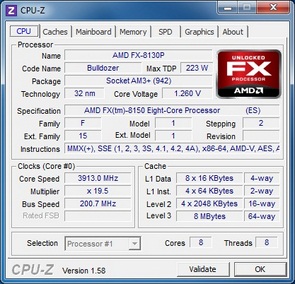AMD FX-8150 8-Core CPU Review: Bulldozer Is Here
More Bulldozer and the AMD FX Line-Up
Looking at the FX-8150’s stand-out features and specifications, it’s easy to see why AMD was so eager to share details over the years. To better illustrate what we mean, take a look at the comparison below, put together by AMD for use in one of their presentations leading up to today’s launch.

Source: AMD
In a direct bullet-point to bullet-point comparison, the FX-8150 no doubt looks promising when compared to Intel’s Core i5 and Core i7 series processors, at least on paper. There is a lot more to designing a higher performance processor than tacking on more cache and cores, boosting frequencies, and adding support for new instructions. Of course, not all cores are created equal. As it turns out, AMD’s eight, higher-clocked cores have trouble competing against four of Intel’s lower-clocked cores—more on that in the benchmark pages ahead. For now, let’s get to some more of the FX-Series specifics...

Initial AMD FX-Series Processor Line-Up
The initial FX-Series product line-up is going to consist of seven processors, ranging from the high-end FX-8150 to the more mainstream FX-4100 (although only four will be available immediately). The processors will differ in their core counts, northbridge frequency, CPU clocks, cache compliments and TDP. Note, that the reduction in available L2 cache is a direct result of disabling a core module. Since each Bulldozer core module contains two cores and 2MB of L2 cache, as each core module is disabled, the L2 is reduced by 2MB. Please note, that all of these initial FX-Series processors will feature the same die; the quad-cores listed here will feature the same 8-core die with two modules disabled.
AMD FX-8150 Processor CPU-Z Details
Here is an up-close-and-personal look at the FX-8150 as reported by the latest version of CPU-Z. As you can see, the FX-8150 uses AMD’s existing AM3+ socket infrastructure. Although it’s pin-compatible with AM3, AM3+ adds support for CPU voltage loadline, increased ILDT current for higher frequency HyperTransport links, increased DRAM current, and two memory channels with official support for speeds of up to DDR3-1866.
If you look through the images above, you’ll notice that the CPU’s voltage and frequency varies due to AMD's Turbo technology. We took steps to capture the images while the FX-8150 was at idle, under a two-thread workload, and while being completely utilized. Doing so allows us to show the actual clocks and voltage of the chip at each “Turbo” stage.

AMD Turbo Technology
The FX-8150 has a base clock of 3.6GHz, which will drop to 1.4GHz while idling thanks to CnQ. When half or less of the FX-8150’s cores are being utilized, the chip is able to hit its max Turbo frequency of 4.2GHz. And when all of the cores are being taxed, the CPU can Turbo up to 3.9GHz to use up any available TDP headroom.










